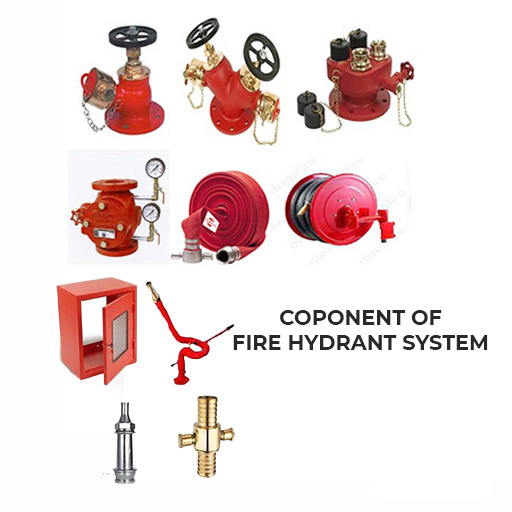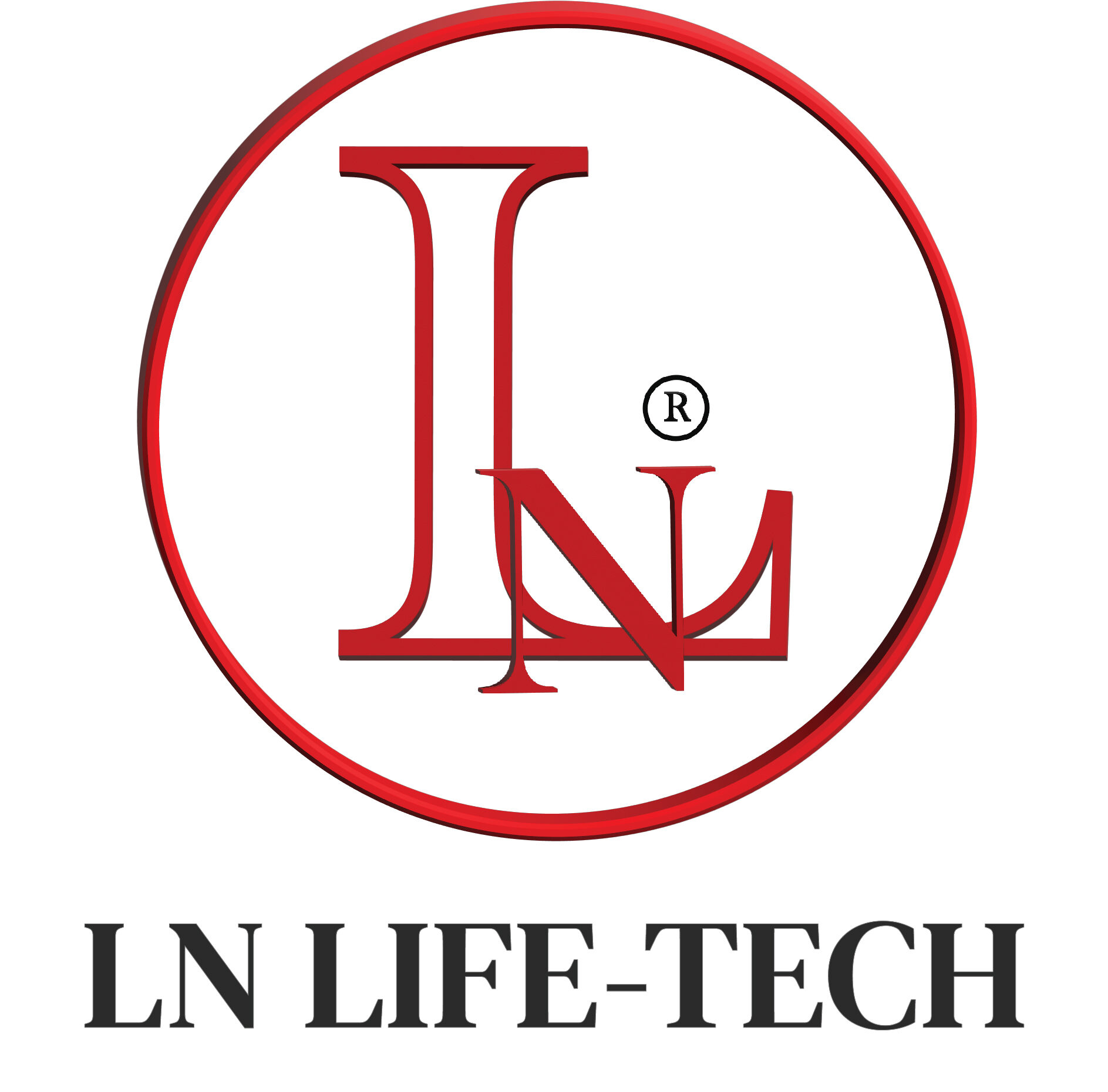Fire Hydrant System
A fire hydrant system consists of a network of piping installed either underground or overhead, strategically positioned around various facilities. Hydrant stand posts, equipped with landing valves, are installed at regular intervals or distances from the protected risks in accordance with the occupancies.
Fire hydrant systems are critical components of fire safety infrastructure, providing quick and efficient access to water for firefighting purposes. With their robust design and automatic activation features, these systems play a crucial role in protecting lives and property in the event of a fire.

Components of the System: A fire hydrant system comprises several components designed to provide a reliable and effective means of delivering water for fire suppression purposes. The main components of a hydrant system include:
1.Water Source: The water source is typically a dedicated water storage tank or a connection to the municipal water supply. It ensures a constant and sufficient supply of water to the hydrant system during fire emergencies.
2.Fire Hydrant: The fire hydrant is the visible above-ground component of the hydrant system. It consists of a valve connected to an underground water main or a water source, allowing firefighters to access pressurized water for fire suppression.
3.Hydrant Valve: The hydrant valve controls the flow of water from the water source to the fire hose. It is typically equipped with a control wheel or a hand wheel that firefighters can operate to open or close the valve as needed.
4.Hydrant Standpipe: The hydrant Standpipe is a vertical pipe connected to the hydrant valve, extending above ground level. It provides a connection point for attaching fire hoses and other firefighting equipment.
5.Hose Coupling: The hose coupling is a fitting attached to the end of a fire hose that allows it to be connected to the hydrant standpipe or other firefighting equipment. It ensures a secure and leak-proof connection between the hose and the hydrant system.
6.Hose Reel: In some hydrant systems, hose reels may be installed in strategic locations for quick deployment during fire emergencies. These reels store lengths of fire hoses that can be easily pulled out and connected to the hydrant standpipe.
7.Nozzles and Branch Pipes: Nozzles and branch pipes are attached to the end of fire hoses to control the direction and flow of water during fire suppression operations. They come in various sizes and types to suit different firefighting requirements.
8.Pressure Reducing Valve: In high-pressure water supply systems, a pressure-reducing valve may be installed to regulate the water pressure delivered to the hydrant system. This ensures that the pressure remains within safe operating limits and prevents damage to firefighting equipment.
9.Auxiliary Equipment: Other auxiliary equipment, such as hydrant wrenches, spanners, and hose racks, may also be included as part of the hydrant system to facilitate the maintenance, operation, and storage of firefighting equipment.
Hydrant Design Criteria for Optimal Fire Safety
1) Assessing Hazard Levels: Determine the type of hazard present—light, ordinary, or high—and tailor the hydrant design accordingly to ensure adequate protection against potential fire risks.
2) Determining Hydrant Quantity: Calculate the required number of hydrants across all facilities based on factors such as building size, layout, and fire risk assessment.
3) Sizing Hydrant Pipes: Ensure proper sizing of pipes in the hydrant network to achieve optimal water discharge rates. Account for the possibility of simultaneous major fires in vulnerable areas to guarantee sufficient water supply.
4) Tank and Vessel Protection: Implement water spray systems to provide combined protection for tankages and pressured storage vessels. Additionally, utilizes foam systems for tankage protection and water spray systems for safeguarding transformers, cable cellars, etc.
5) Fire Water Pump Selection: Select appropriate fire water pumps and ensure they are adequately sized to meet the required pumping capacity. The provision of water must be ensured to support the installed pumping capacity.
6) Trained Manpower: Employ trained personnel capable of handling disastrous situations effectively to minimize potential damage and ensure swift response to fire emergencies.
7) Compliance with Codes: Ensure compliance with relevant fire safety codes and standards throughout the design process to guarantee adherence to legal and regulatory requirements.
Hydrant Placement Guidelines
1.Yard Hydrants: Install yard hydrants at regular intervals (60m, 45m, or 30m) around the perimeter of buildings based on hazard level. These hydrants should be situated between 1.5m to 15m from external walls to ensure accessibility during emergencies.
2.Internal Hose Reels: Provide internal hose reels strategically within the building to ensure that no part of the building is more than 30m away from the nearest hose reel, facilitating quick access to firefighting equipment.
3.Upper Floor Protection: Protect all upper floors with hydrant wet risers and landing valves located at each landing of external or protected internal staircases, ensuring comprehensive fire safety coverage throughout the building.
1.Hydrant System
2.Wet Riser System
3.Spray System for Storage Tank
4.Medium Velocity Water Spray System For Transformer
5.YARD HYDRANT
By adhering to these hydrant design criteria and placement guidelines, you can enhance the fire safety preparedness of your premises and mitigate potential risks effectively.
Wet Riser System
A wet riser system is a type of fire protection system commonly found in high-rise buildings, commercial complexes, and industrial facilities. It consists of a network of vertical pipes or risers that are permanently charged with water and connected to a pressurized water supply. The term “wet” refers to the fact that the pipes are constantly filled with water, ready for immediate use in the event of a fire.

Key components of a wet riser system include:
1.Riser Pipes: Vertical pipes that run the height of the building and are typically made of durable materials such as steel or copper. These pipes are equipped with outlet valves at each floor level for connecting firefighting hoses.
2.Inlet Connection: A connection point located at ground level where the riser system is connected to the building’s water supply. This connection ensures a constant flow of water to the riser pipes.
3.Outlet Valves: Valves located at each floor level that control the flow of water from the riser pipes. Firefighters can open these valves to access the water supply and connect hoses for firefighting operations.
4.Pressure Maintenance: Devices such as pressure-reducing valves and pressure relief valves are installed to maintain adequate water pressure within the riser system, ensuring effective firefighting performance.
5.Drainage: Drain valves are installed at the lowest points of the system to allow for drainage and prevent waterlogging when the system is not in use.
Yard Hydrant
A yard hydrant, also known as a yard valve or a post hydrant, is a type of outdoor water supply fixture commonly used for various purposes, including firefighting, irrigation, and general water access in residential, commercial, and industrial settings. It typically consists of a vertical pipe or standpipe with a valve assembly at the top, installed above ground level for easy access.

Key features and components of a yard hydrant include:
1. Standpipe: The main vertical pipe that extends above the ground level, usually made of durable materials such as cast iron, ductile iron, or galvanized steel. It serves as the primary structural component of the hydrant and provides support for the valve assembly.
2.Valve Assembly: Located at the top of the standpipe, the valve assembly consists of a control valve or handle that can be operated to control the flow of water. This valve allows users to turn the water supply on or off as needed.
3.Outlet: A threaded or hose connection at the base of the standpipe where hoses or other water distribution equipment can be attached. This outlet allows users to access the water supply for various applications, such as watering gardens, filling buckets, or connecting firefighting hoses.
4.Protective Cover: Many yard hydrants feature a protective cover or cap to shield the valve assembly from the elements and prevent debris, dirt, or contaminants from entering the system. This cover helps to maintain the integrity of the hydrant and ensures smooth operation over time.
5.Frost Protection: In regions where freezing temperatures are common, yard hydrants may be equipped with frost-proof or freeze-resistant features to prevent the water supply from freezing and causing damage to the system. These features typically include an underground shut-off valve that drains water from the standpipe when the hydrant is not in use.

